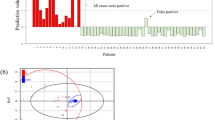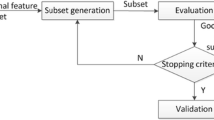Abstract
The detection of lung cancer has a special value in the diagnosis of cancer diseases. Based on nine elemental concentrations (i.e., chromium, iron, manganese, aluminum, cadmium, copper, zinc, nickel, and selenium) in urine samples and an ensemble linear discriminant analysis (ELDA), a detection method for lung cancer has been developed. A dataset containing 30 healthy samples and 27 lung cancer samples is used for experiment. The whole dataset was first split into a training set with 29 samples and a test set with 28 samples. The prediction results from the ELDA classifier were compared with those from single Fisher’s discriminate analysis (FDA). On the test set, the ELDA classifier achieved better performance, that is, a sensitivity of 100%, a specificity of 86.7%, and an overall accuracy of 92.9%, while the FDA classifier had a sensitivity of 92.3%, a specificity of 93.3%, and an overall accuracy of 92.9%. The superiority of ELDA to FDA is ascribed to the fact that ELDA can model more nonlinear relationships through the cooperation of several single models, suggesting that ensemble modeling is more advisable in such a task.







Similar content being viewed by others
References
Ebrahim AM, Eltayeb MAH, Shaat MK, Mohmed NMA, Eltayeb EA, Ahmed AY (2007) Study of selected trace elements in cancerous and non-cancerous human breast tissues from Sudanese subjects using instrumental neutron activation analysis. Sci Total Environ 383:52–58
Greenlee RT, Hill-Harmon MB, Murray T, Thun M (2001) Cancer statistics, 2001. CA Cancer J Clin 51:15–36
Huang ZW, Mcwilliams A, Lui H, Mclean D, Lan S, Zeng HS (2003) Near-infrared Raman spectroscopy for optical diagnosis of lung cancer. Int J Cancer 107:1047–1052
Khanmohammadi M, Ansari MA, Bagheri Garmarudi A, Hassanzadeh G, Garoosi G (2007) Cancer diagnosis by discrimination between normal and malignant human blood samples using attenuated total reflectance-fourier transform infrared spectroscopy. Cancer Invest 25:397–404
Smith RA, Mettlin CJ (2001) Cancer detection, Chap 5. In: Lenhard RE, Osteen RT, Gansler T (eds) Clinical oncology. The American Cancer Society Inc., Atlanta, GA, pp 75–122
Kondepat VR, Heise HM, Backhaus J (2008) Recent applications of near-infrared spectroscopy in cancer diagnosis and therapy. Anal Bioanal Chem 390:125–139
Swierenga SHH, Gilman JPW, McLean JR (1987) Cancer risk from inorganics. Cancer Metastasis Rev 6:113–154
Fortea G, Alimonti A, Violantea N, Gregorioa MD, Senofontea O, Petruccia F, Sancesariob G, Bocca B (2005) Calcium, copper, iron, magnesium, silicon and zinc content of hair in Parkinson’s disease. J Trace Elem Med Biol 19:195–201
Bianchi F, Maffini M, Mangia A, Marengo E, Mucchino C (2007) Experimental design optimization for the ICP-AES determination of Li, Na, K, Al, Fe, Mn and Zn in human serum. J Pharm Biomed 43:659–665
Frisk P, Ola Darnerud P, Friman G, Blomberg J, Ilbäck NG (2007) Sequential trace element changes in serum and blood during a common viral infection in mice. J Trace Elem Med Biol 21:29–36
Snow ET (1992) Metal carcinogenesis: mechanistic implications. Pharmac Ther 53:31–65
Zhang ZY, Zhou HL, Liu SD, Harrington P (2006) An application of Takagi–Sugeno fuzzy system to the classification of cancer patients based on elemental contents in serum samples. Chemom Intell Lab Syst 82:294–299
Bower JJ, Leonard SS, Shi X (2005) Conference overview: molecular mechanisms of metal toxicity and carcinogenesis. Mol Cell Biochem 279:3–15
Kilic E, Saravmen R, Demiroglu A, Ok E (2004) Chromium and manganese levels in the scalp hair of normals and patients with breast cancer. Biol Trace Elem Res 102:19–25
Yaman M (2006) Comprehensive comparison of trace metal concentrations in cancerous and noncancerous human tissues. Curr Med Chem 13:2513–2525
Tan C, Chen H, Xia CY (2009) The prediction of cardiovascular disease based on trace element contents in hair and a classifier of boosting decision stumps. Biol Trace Elem Res 129:9–19
Schwartz MK (1975) The role of trace element in cancer. Cancer Res 35:3481–3487
Gurusamy K, Davidson BR (2007) Trace element concentration in metastatic liver disease—a systematic review. J Trace Elem Med Bio 21:169–177
Raju GJN, Sarita P, Kumar MR, Murty GAVR, Reddy BS, Lakshminarayana S, Vijayan V, Lakshmi PVBR, Gavarasana S, Reddy SB (2006) Trace elemental correlation study in malignant and normal breast tissue by PIXE technique. Nucl Instrum Meth Phys Res B 247:361–367
Tan C, Chen H, Xia CY (2010) Application of boosting classification and regression to modeling the relationships between trace elements and diseases. Biol Trace Elem Res 134:146–159
Mevik BH, Segtnan VH, Næs T (2004) Ensemble methods and partial least squares regression. J Chemometr 18:498–507
Su QD, Tong WD, Shi LM, Shao XG, Cai WS (2006) A partial least squares–based consensus regression method for the analysis of near–infrared complex spectral data of plant samples. Anal Lett 39:2073–2083
Tan C, Qin X, Li ML (2008) An ensemble method based on a self-organizing map for near-infrared spectral calibration of complex beverage samples. Anal Bioanal Chem 392:515–521
Wichard JD, Cammann H, Stephan C, Tolxdorff T (2008) Classification models for early detection of prostate cancer. J Biomed Biotechnol 2008:218097
Krogh A, Sollich P (1997) Statistical mechanics of ensemble learning. Phys Rev E 55:811–825
Geman S, Bienenstock E, Doursat R (1992) Neural networks and the bias/variance dilemma. Neural Comput 4:1–58
Naftaly U, Intrator N, Horn D (1997) Optimal ensemble averaging of neural networks. Network: Comput Neural Syst 8:283–296
Breiman L (1996) Bagging predictors. Mach learn 24:123–140
Chiang LH, Russell EL, Braatz RD (2000) Fault diagnosis in chemical processes using Fisher discriminant analysis, discriminant partial least squares, and principal component analysis. Chemom Intel Lab Syst 50:243–252
DD Chen (2007) The methodology on the trace element chemical pattern recognition for early diagnosing lung cancer and cardiovascular diseases (Dissertation), Shenyang Pharmaceutical University in China
Chen DD, Li D, Liu J, Zhao CJ (2007) Determination of trace elements in urine of the normal persons in Shenyang City. Guangdong Trace Elements Science 14:14–17
Chua AC, Morgan EH (1996) Effects of iron deficiency and iron overload on manganese uptake and deposition in the brain and other organs of the rat. Biol Trace Elem Res 55:39–54
Gupta SK, Shukla VK, Vaidya MP, Roy SK, Gupta S (1993) Serum and tissues trace elements in colorectal cancer. J Surg Oncol 52:172–175
Newberne PM, Schrager TF, Broitman S (1997) Esophageal carcinogenesis in the rat: zinc deficiency and alcohol effects on tumor inductions. Pathobiology 65:39–45
Singh V, Garg AN (1998) Trace element correlations in the blood of Indian women with breast cancer. Biol Trace Elem Res 64:237–245
Schrauzer GN, White DA, Schneider CJ (1977) Cancer mortality correlation studies III: statistical associations with dietary selenium intakes. Bioinorg Chem 7:23–34
Gerhardsson L, Brune D, Nordberg IG, Wester PO (1985) Protective effect of selenium on lung cancer in smelter workers. Br J Ind Med 42:617–626
Schrauzer GN (2009) Selenium and selenium-antagonistic elements in nutritional cancer prevention. Crit Rev Biotechnol 29(1):10–17
Zhong SY, Tao ZP, Wang JC (1996) Determination of 6 kind tract elements in the serum, urine, hair the patients with bladder tumors. Studies of Trace Element and Health 13:18–19 (In Chinese)
Acknowledgments
This work was supported by the Sichuan Province Science Foundation for Youths (09ZQ026-066) and Scientific Research Startup Fund for Doctor, Yibin University (2008B06). The authors thank Ms. Chen D. for providing the dataset in this paper.
Author information
Authors and Affiliations
Corresponding author
Rights and permissions
About this article
Cite this article
Tan, C., Chen, H. & Wu, T. Classification Models for Detection of Lung Cancer Based on Nine Element Distribution of Urine Samples. Biol Trace Elem Res 142, 18–28 (2011). https://doi.org/10.1007/s12011-010-8748-4
Received:
Accepted:
Published:
Issue Date:
DOI: https://doi.org/10.1007/s12011-010-8748-4




